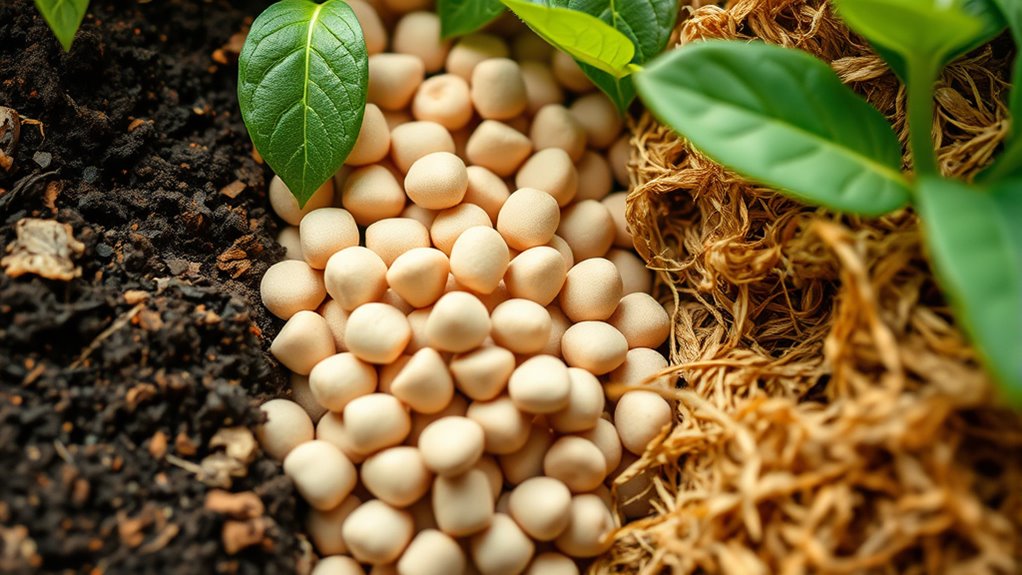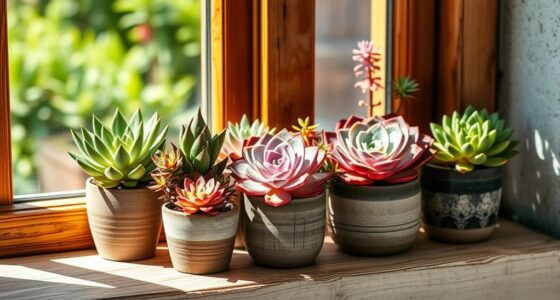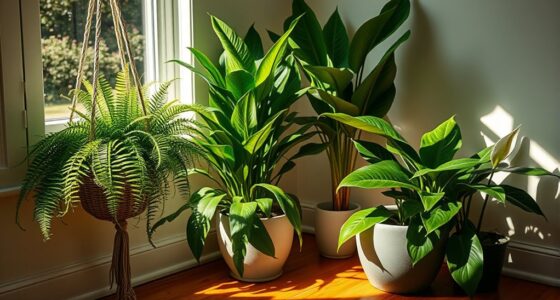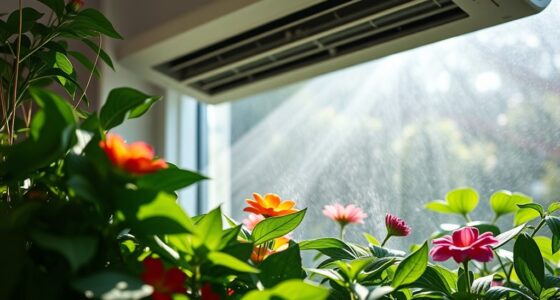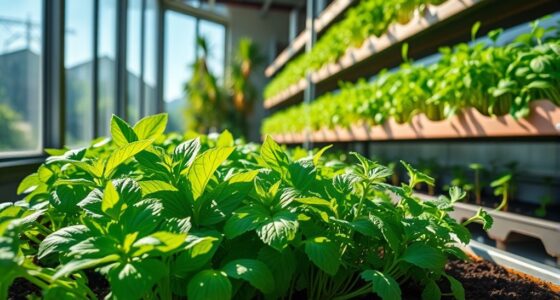Choosing between soil and soilless media like LECA or coco coir depends on your plant’s water and nutrient needs. Soil retains moisture and supplies nutrients naturally but can cause overwatering or pests if not managed well. Soilless options drain quickly and require regular fertilizing, making them ideal for cleaner setups and plants needing precise watering. Understanding these differences helps you pick the best medium for healthy, thriving indoor plants—discover more insights as you explore your options.
Key Takeaways
- Soil retains moisture and nutrients naturally, ideal for low-maintenance plants but risks overwatering and root rot without proper drainage.
- Soilless media like LECA drain quickly and are sterile, requiring regular fertilization for healthy root development.
- Coco coir balances moisture retention with good aeration, supporting healthy roots and reducing overwatering issues.
- Soil provides beneficial microbes and gradual nutrient release, while soilless options need supplemental feeding and microbial inoculation.
- Choice depends on plant needs and maintenance preferences; soil suits moisture-loving plants, while soilless media suit cleaner, pest-resistant setups.
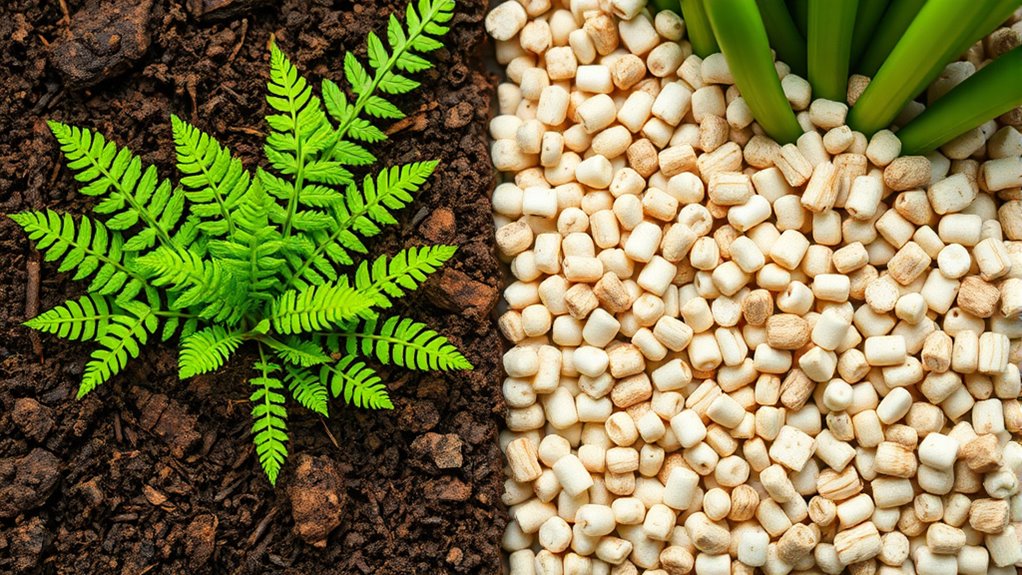
Soil typically offers excellent water retention because of its organic components, which hold moisture for longer periods. This can be beneficial if you’re prone to forgetting to water or if your plants prefer consistently moist soil. However, too much water retention can lead to problems like root rot, especially if the soil doesn’t drain well. Conversely, soilless mediums like LECA (lightweight expanded clay aggregate) tend to drain quickly, preventing overwatering but requiring more frequent watering. Coco coir strikes a balance by retaining enough moisture while still providing good drainage, making it more forgiving than some other soilless options. Additionally, the type of medium influences the root health and overall vitality of your plants. Nutrient availability varies considerably between soil and soilless mediums. Soil naturally contains nutrients and beneficial microbes, which can make feeding plants easier since they gradually release nutrients over time. You often need fewer supplements when using soil, especially if it’s rich and healthy. Soilless media, on the other hand, are usually inert or low in nutrients, meaning you’ll need to add fertilizers regularly to meet your plants’ needs. For example, LECA is sterile and provides no nutrients, so you must rely on liquid fertilizers to supply essential elements. Coco coir has some natural nutrients but often requires supplementation as well, especially during active growth phases. Choosing between soil and soilless media also means considering your plant’s specific needs and your maintenance style. If you prefer a low-maintenance setup with fewer feedings, soil or nutrient-rich potting mixes might be better. If you’re comfortable with more frequent watering and fertilizing, soilless options like LECA or coco coir can offer a cleaner, pest-resistant environment. Both types of mediums have their advantages and drawbacks, but understanding how they handle water retention and nutrient availability helps you make an informed decision. By selecting the right medium for your indoor plants, you’ll foster healthier growth and enjoy a more successful gardening experience.
Frequently Asked Questions
How Do I Switch Plants From Soil to Soilless Media Safely?
When switching your plants from soil to soilless media, you want to minimize transplant shock and promote root adaptation. Gently remove the plant from its soil, carefully loosen the roots, and rinse off excess soil. Place it into the new media, ensuring roots are well-covered. Water thoroughly and keep the environment stable. Over time, this process helps your plant adjust smoothly without stressing it out.
Which Potting Medium Is Best for Succulents and Cacti?
For succulents and cacti, you need a cactus potting mix that meets their soil requirements for excellent drainage and aeration. Look for a mix with coarse sand, perlite, or pumice, which prevents water retention and root rot. Avoid regular potting soil, as it retains too much moisture. Using a specialized cactus or succulent soil helps your plants thrive by mimicking their natural environment.
Are There Specific Nutrients Required for Soilless Media?
When using soilless media, you need to pay attention to fertilizer requirements because these media often lack essential nutrients. You should regularly provide a balanced, water-soluble fertilizer to prevent nutrient deficiencies that can hinder your plant’s growth. Unlike traditional soil, soilless mixes don’t hold nutrients well on their own, so staying proactive with feeding guarantees your indoor plants stay healthy and thriving.
How Often Should I Water Plants in Different Media Types?
Imagine your plant as a thirsty traveler. Watering frequency depends on your media; for example, Leca needs less frequent watering due to excellent moisture retention, while coco retains moisture longer than traditional soil. Check your plant’s needs daily, adjusting based on humidity and media type. Typically, water when the top inch feels dry, ensuring proper hydration without overwatering. Your attentive care keeps your indoor garden thriving.
Can I Use a Combination of Soil and Soilless Media?
Yes, you can definitely use a combination of soil and soilless media. Mixed media works well for layered planting, giving your indoor plants better drainage and nutrient balance. You might layer soil with Leca or coco coir, creating a customized environment that boosts plant health. Just make certain the layers are well-balanced, and avoid overwatering. This approach offers the benefits of both media types, supporting healthy, vibrant indoor plants.
Conclusion
Think of choosing your potting media as selecting the perfect sailing ship. Soil is like a sturdy, traditional vessel, offering deep roots and familiarity. Soilless mediums are the sleek, modern yachts—lighter and more adaptable. Whichever you choose, remember you’re the captain steering your indoor garden. With the right media, your plants will glide smoothly through their growth voyage, flourishing along the way. Set your course wisely, and enjoy the beautiful journey of your thriving indoor oasis.

